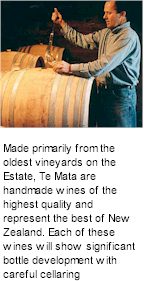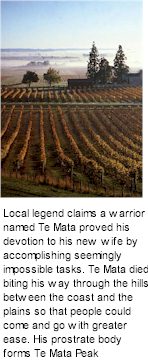


Te Mata is a New Zealand family owned winery – a true estate, specialising in grape growing and winemaking from its ten Hawke’s Bay vineyards. Acknowledged as one of only five icon wineries in New Zealand. Te Mata’s completely handmade wines are renowned as the country’s finest. Under the direction of John Buck, Te Mata Estate has, over nearly thirty years, produced a stunning array of red and white wines including such famous labels as Coleraine and Awatea Cabernet/Merlots, Bullnose Syrah, Elston Chardonnay and Cape Crest Sauvignon Blanc. Not content to rest on its laurels, Te Mata has also developed a unique single vineyard from which it produces its Woodthorpe and Rymer’s Change wines.

Te Mata Estate Winery originated as part of Te Mata Station, a large pastoral land holding established by English immigrant John Chambers in 1854. His third son, Bernard, influenced by the comments from visitors that the hills were suitable for grape growing, planted vines in 1892. Wine was made from those grapes in 1896, establishing Te Mata Estate as the first winery in New Zealand to make a century. By 1909 17 hectares of vines were being cultivated and in that year 55,000 litres of 'claret, hock and madeira' were made by the Australian-born manager, J O Craike.
The Chambers sold the property in 1919. It had various owners until it was acquired by the current owners in 1978. Both vineyards and winery were run down, although still making wine. The opportunity to purchase brick cellars, dating from 1872, and two wonderful vineyard sites were irresistible to the Bucks and the Morris's, the two families behind the current company.
More land was acquired by ownership, lease and management contract. All the original vineyards were replanted and viticulture underwent a further detailed review when Dr Richard Smart was engaged as a consultant in 1989. Peter Cowley joined as winemaker in 1984 and is now a participant in the company. Under his direction, all the winemaking techniques are monitored and kept in tune with a strict policy of producing small lots of high-quality wine from estate properties.

Te Mata Estate currently produces 25,000 cases of wine and is at full production. Sixty percent of this is red. Another feature of Te Mata Estate is its architecture. Apart from the restored original building the rest of the premises have been progressively built since 1987. Both the winery buildings and the Buck family home, Coleraine, across the road from the winery, were designed by Wellington architect lan Athfield.
Athfield's brief was to create a New Zealand winery environment which did not copy the traditions of other winemaking countries. Local materials were to be used. Circular and square forms and the use of a range of limewash colours chosen. A visit to Te Mata Estate, from the entrance over a gently arched bridge to a stroll through a cloistered walkway past gardens, fish ponds and courtyards, makes tasting and buying wine a pleasant and relaxed experience.
These vineyards are all located in Hawkes Bay (within 30 minutes drive of the winery) and under the direct control of Te Mata Estate's viticultural team. Te Mata Estate is firmly committed to protecting the environment and therefore runs its vineyards and winery in accordance with the practices of Sustainable Winegrowing New Zealand.
Te Mata has 6 vineyards totalling 37 acres (15 hectares) on the free draining soils of the north-facing slopes of Havelock Hills. Containing three of the oldest vineyards in New Zealand (first planted in the 1890's), the majority of Te Mata's finest wines come from this area, which produces wines that balance power and elegance.
